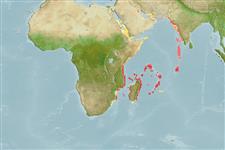Environment: milieu / climate zone / depth range / distribution range
Écologie
marin récifal; profondeur 4 - 28 m (Ref. 92868). Tropical
Western Indian Ocean: Mascarene Islands. Non-type specimens from the Pacific Ocean area are tentatively identified as T. randalli (Line Is., Kiritimati I.; Amer. Samoa; Solomon Is.; Vanuatu; Gilbert Is.).
Taille / Poids / Âge
Maturity: Lm ? range ? - ? cm
Max length : 9.9 cm SL mâle / non sexé; (Ref. 92868)
Épines dorsales (Total) : 9; Rayons mous dorsaux (Total) : 11; Rayons mous anaux: 12. This small species has a non-elongated nasal spine base, height of spine about equal to preocular spine height; snout length about 3.2-3.5 times in HL; iris lappet crenate (Ref. 92868).
Life cycle and mating behavior
Maturité | Reproduction | Frai | Œufs | Fécondité | Larves
Knapp, L.W., 2013. Descriptions of four new species of Thysanophrys (Scorpaeniformes: Platycephalidae) from the Western Indian Ocean. Zootaxa 3608(2):127-136. (Ref. 92868)
Statut dans la liste rouge de l'IUCN (Ref. 130435: Version 2024-1)
Menace pour l'homme
Harmless
Utilisations par l'homme
Outils
Articles particuliers
Télécharger en XML
Sources Internet
Estimates based on models
Preferred temperature (Ref.
123201): 25.1 - 28.9, mean 27.2 °C (based on 301 cells).
Phylogenetic diversity index (Ref.
82804): PD
50 = 0.5010 [Uniqueness, from 0.5 = low to 2.0 = high].
Bayesian length-weight: a=0.00457 (0.00230 - 0.00908), b=3.09 (2.91 - 3.27), in cm total length, based on LWR estimates for this (Sub)family-body shape (Ref.
93245).
Niveau trophique (Ref.
69278): 3.5 ±0.6 se; based on size and trophs of closest relatives
Fishing Vulnerability (Ref.
59153): Low vulnerability (10 of 100).
